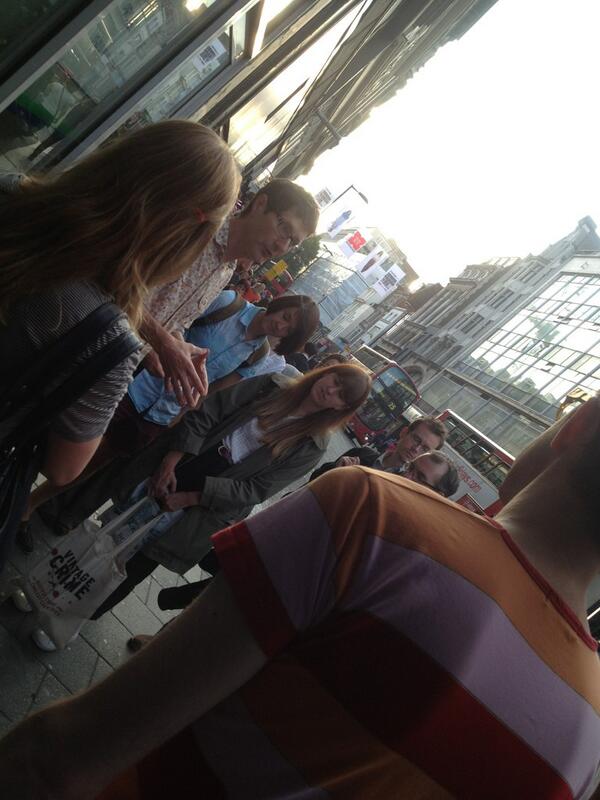This week I took London book buyers on a soundwalk (part of promoting Sonic Wonderlands which comes out in early 2014). If you’ve never done a soundwalk, I would recommend trying it. If you’re in london, you can follow the instructions I used which are at the end of this blog.
What did the participants think?

“It makes you listen v differently, and distinctly. So interesting! We went to Soho Square, churches, Covent Garden listening to London life.” @Franandherbooks
“Muchos thanks to @trevor_cox & @TheBodleyHead for our sonic adventure last night…my ears will never be the same again.” @vintagebooks
Soundwalk Instructions
 The instructions for a soundwalk are relatively simple, just walk and observe the sounds you hear. Maintaining silence between participants is vital. Along the walk we will pause in various places where we can discuss what you have heard.
The instructions for a soundwalk are relatively simple, just walk and observe the sounds you hear. Maintaining silence between participants is vital. Along the walk we will pause in various places where we can discuss what you have heard.
Soundwalking began in sound art and acoustic ecology. Composer and sound ecologist Hildegard Westerkamp describes soundwalking as ‘any excursion whose main purpose is listening to the environment. It is exposing our ears to every sound around us no matter where we are’. [1] In more recent years, the technique has been picked up by scientists and geographers as a way of exploring what people think about urban soundscapes. This soundwalk is based on one used by the Positive Soundscape Project, the largest study into urban sound ever undertaken in the UK. [2]
From Tottenham Court Road Tube Station walk west along Oxford Street on the pavement along the south side of the road. Listen to the sounds of the consumer economy. Turn left (south) into Soho Street and notice how the noise recedes behind you. Pause in the centre of Soho Square where more subtle sounds of people chatting and birdsong emerge.
Exit by the east gate, cross over the road and enter St. Patrick’s Church through the portico underneath the tall red brick tower. Notice a sense of aural enclosure and relative stillness as you enter. If not too disturbing to others, enter the nave, where if you’re lucky a worshiper might cough to reveal the reverberance of the church.
Exit the church, turn left and head roughly south. Leave the square by Greek Street. After 50 metres, turn left under the Pillars of Hercules into Manette Street, and follow this to Charing Cross Road. Where is the “threshold of discomfort” [3] where the quieter sound of the back streets is lost to the roar of the traffic on the main road. Carefully cross the main road. Turn right. After the Phoenix Theatre, turn left into Phoenix Street. Walk along this road until the t-junction at the bottom.
Ahead is Phoenix Garden, but the entrance is on the other side and you need to circle around the garden by first turning right and then following the wall/railings anti-clockwise. Can you hear nature in this urban refuge, or is the ventilation hum dominant?
Exit the gardens and go south-east, crossing over Shaftesbury Avenue. This busy road might give you a chance to “practice your aural flexibility by mentally closing out the traffic noise”. [3] Continue along Mercer Street to reach the Seven Dials pillar. Take second left and walk along Shorts Garden keeping an eye out for the entrance to Thomas Neal’s shopping centre. Go straight through the shopping centre to experience a soundscape of consumption.
As you exit the shopping centre, turn left then immediately right into Neal Street. Cross over Long Acre and head down into Covent Garden. Does the cobbles change the sound of your footsteps? Enjoy the sound of street entertainment and the hubbub of the cafes around the square. Can you hear any traffic or aircraft?
Exit Covent Garden along King Street (to the right of St Paul’s Church) going south-west. Turn right into Garrick Street and right into Rose Street to reach the Lamb and Flag pub.
On the walk, did you find any sounds that are typical of London’s soundscape?
Thanks to Neil Bruce for his help working out the route. Where else would be a good place for soundwalking? Please comment below.
Notes
[1] Autumn Leaves, Sound and the Environment in Artistic Practice, Ed. Angus Carlyle, Double Entendre, Paris, 2007, p. 49.
[2] http://usir.salford.ac.uk/2460/
[3] R. Murray Schafer (ed.), European Sound Diary (Vancouver, 1977).
0 responses to “A London Soundwalk”
[…] Instructions for a soundwalk in central London and some thoughts from the book buyers who went on it. […]
[…] Instructions for a soundwalk in central London and some thoughts from the book buyers who went on it. […]
I did this in Paris about ten years ago with mics mounted at my ears to make a binaural recording of the experience. It was wonderful to share this experience with headphone equipped family when I returned to the US. If I were to listen to it again today, I’m sure I could close my eyes and retrace nearly every step.
[…] now, follow this link for Prof Cox’s description of his audio walk. In due time i’ll upload my audio walk of London’s uniquely diverse […]